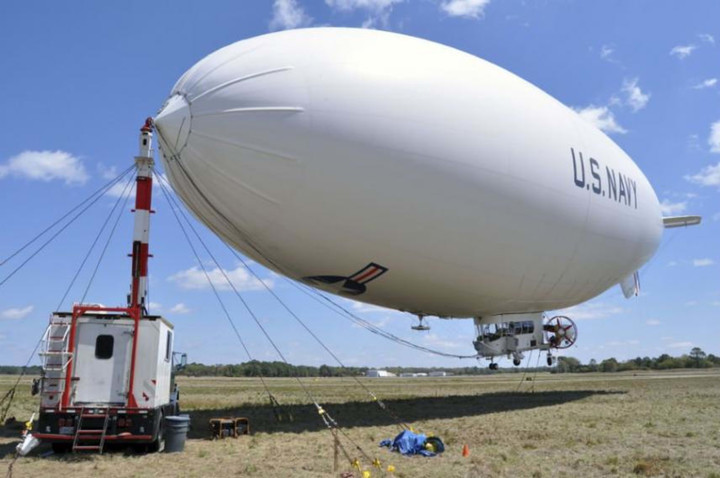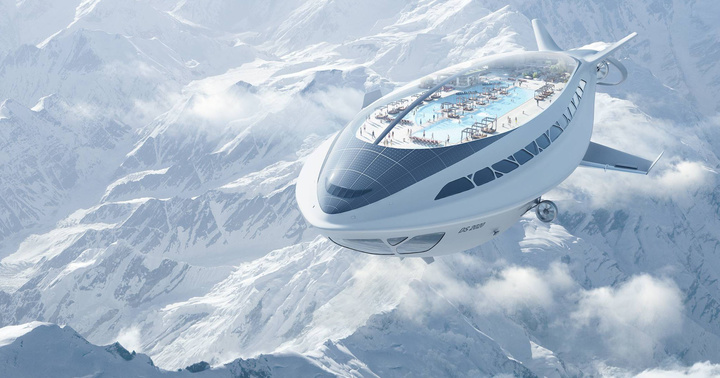This article comes from the translation team of the translation team of 36 氪, the translator soldier, and Ai Faner is authorized to publish it.
Airplane pollution is too serious. What should be used to replace cargo by airplane? An airship is a good choice. An airship does not need much energy to transport a large amount of materials. What fuel does it use? Is it dangerous? With these questions, let’s hear the explanations of experts. This article is compiled from the original article entitled “Planes Are Ruining the Planet. New, Mighty Airships Wo n’t.”
In August of this year, Greta Thunberg drove a zero-emission ship across the Pacific Ocean, and she used this behavior to protest against planes because of the high carbon emissions of air travel. One day, she might go on an airship to complete her trip because the airship is environmentally friendly. At the beginning of the 20th century, airships were popular for some time, but then they fell. Airships are faster than cargo ships and can land on land and on the beach. Compared with ships, many airships (also called airships) are more environmentally friendly, and their carbon emissions are much lower than airplanes.
Although everyone was obsessed with airships, this love soon faded, because airships are too slow, sometimes too dangerous, the climate is changing, and aircraft are becoming more and more popular. Until now, some scientists have turned their attention to airships. They think that airships are a viable means of transportation.

Unlike airplanes, airships do not need to burn too much fuel when taking off and cruising. Because airships are slower than airplanes, we can use them to carry cargo, and its carbon emissions are lower. In the next few decades, air cargo volume will increase by two times. IATA press spokesman Jean Baptiste Meusnier said: “Compared to traditional aviation tools, spacecraft have 80-90% less carbon emissions.”
In September, Energy Conservation and Management published an article stating that if an airship can drive a natural stream of rapids, it can move 21,000 tons of cargo with almost no energy consumption. There is a narrow area in the atmosphere where the air flows fast. It is located above the troposphere, where airships can fly, and planes fly there.
Australia Institute of Applied Systems Analysis researcher and report lead author Julian David Hunt said that the wind speed in this area can reach 100 miles per hour (161 kilometers) and the top speed can reach 250 miles (402 kilometers), as long as 7 It can fly from Denver, USA to China in 4 days, and Los Angeles to Tokyo in 4 days.
Hunt’s airship flies in the stratosphere. This area has many advantages. Besides natural wind, there are other advantages. Hunt explained: “You can plan a long time in advance, because the weather here is easier to predict … and there are fewer disturbances here, and it is easier to predict wind patterns in the stratosphere.” He believes that humans can build a global Flying lines, airships don’t need energy to carry cargo. Only Hunt think so? no.
Lockheed Martin Project Manager Bob Boyd said that because of its unique physical characteristics, airships are inherently highly energy-efficient. Bob Boyd also said: “Compared with direct lift, moving with buoyancy is obviously more energy efficient.” Airplanes and helicopters rely on direct lift to fly and require fossil fuels. If you fly with buoyancy, you only need to rely on the nature of hydrogen, helium and other gases The characteristics are enough, these gases are lighter and do not require fuel.
However, Hunt said that the airship relies on air currents at high altitudes, so it needs super soft materials for manufacturing. This material does not exist yet. “Finding materials with strong structures has always been a challenge,” said Jason Rhodes, senior research scientist at NASA’s Jet Propulsion Laboratory. That’s why, among other reasons, companies that make commercial airships are reluctant to venture in. TheyThe airship flies under the stratosphere, flying at an altitude of about 5000-6000 feet, which can solve the pressure problem and shorten the vertical flight time.

These low-altitude flying tools are called hybrid airships, and they will become mainstream in the future. Lockheed Martin’s hybrid prototype airship has three cartoon-like bubbles on the front, and with navigation and engine systems, the airship can be very operable. Lockheed Martin’s prototype hybrid airship uses only 20% of aerodynamic lift, and 80% of its power comes from buoyancy. Because of this, hybrid airships have much lower energy than planes and can enter many areas that other vehicles cannot reach.
In addition to environmental protection, airships have other benefits. Prentice said that in Northern Canada, ice roads (roads formed by frozen lakes) are melting, and access to some areas will be more difficult, and housing and food will become increasingly scarce.
BASI is building a large airship, hoping that it can carry a large amount of cargo, such as construction equipment, modular dwellings, and does not require roads. They can connect remote areas and areas without roads. Once there is such an airship, roads may no longer be needed, road repair costs are high, and the environment is destroyed. Most airships can land on flat areas, such as water, snow, sandy beaches, or other sites, without the need for roads.
Although it is slower, it can be an advantage to land anywhere. When a container ship unloads, it will stop on an alternate line,Cars can cause congestion. An airship is not the same. It can distribute loading by region. If the cargo (such as new cars and trucks) is large enough, it can directly transport the cargo from the factory to its destination, thereby bypassing the crowded city and without crossing the waterway.
In addition, airships are not limited by the size of truck containers and train cars, so we can use it to transport oversized vehicles, machinery and equipment to hard-to-reach places, such as construction sites, crowded cities, and mining areas. Lockheed Martin said on the website: “If you want to ship a large amount of cargo, such as already assembled heavy equipment, there will be a weight limit on the cargo when it is transported by airship, but there is no size limit.”
Because of its many advantages, using airships to complete humanitarian and disaster rescue missions is perfect. “When storms, tsunamis, and earthquakes come, the first thing to hit is infrastructure,” Boyd said. The 2004 tsunami hit India is a good example. The 2,000-mile coastline is affected, and even with large helicopters, heavy supplies such as fresh water and food cannot be transported. Straightline Aviation COO Mark Dorey said, “Compared to helicopters, airships are more versatile, safer, more environmentally friendly, and have a wider range of operations.”
Because the airship can stay in the sky for a long time, it can complete long-term tasks, such as investigation, long-range detection of border security, and scientific monitoring. At present, a near-Earth satellite can only capture details of a certain place every 2 hours. As for a geosynchronous satellite, it is farther from the ground and the resolution of the photos taken is lower. An airship can fill the void and it can continuously monitor a certain location. NASA researcher Rhodes said, “With an airship, you can understand how a certain place changes with the seasons, and you can also investigate changes in the ocean and agricultural conditions. During the high season of fire, the airship can always track and detect when it finds a fire Time, you can continue to observe for days or even months. “
An airship is much quieter than an airplane, and its noise is similar to a large car engine, but it is thousands of feet away from the ground, so it will not affect the ground.
Many companies are developing airships, but their designs are different. Which gas is used to fill the airship? Everyone has been arguing. Lockheed Martin, Varialift, Flying Whales (invested by China and France) use helium, Hunt’s hybrid airship relies on hydrogen, BASI airships also use hydrogen, and solar panels.
Hydrogen has some advantages: it is cheap, it can be made from renewable energy, its lift is 6-8% stronger than helium, and it is flammable. Helium does not burn, so it is safer, but Prentice claims that today’s technology is advanced enough to prevent airships from exploding and only explode when the hydrogen concentration is greater than 4%. Gasoline can ignite if it reaches 1%, so it is much more dangerous than hydrogen. To some people, the risk of hydrogen does notNot worth it. Boyd said, “The lift of hydrogen is not particularly large. Should we really give up the inert gas and replace it with a flammable gas?”
For safety reasons, the future of helium is brighter in the future. There is less and less helium on Earth, but Boyd reports that there is no problem with helium supply. Hydrogen may not be that safe, but it is not bad to use it in an airship because it does not pollute the environment.
In the early days of the airship, weather changes caused many accidents. Everyone was worried that the storm might trap the balloons. This worry was a bit overdone because today’s airships are quite huge. Prentice said: “The airship does not need to fly above the weather. If it is a real large airship, such as an airship used to carry cargo, it has sufficient inertia, so it will not be affected by the weather and will not have a big impact.
When we see the huge airship passing over our heads, there will be a feeling of going back to the past, and a feeling of facing the future. Lockheed Martin’s project has received FAA approval, and Boyd believes it may take another 2-3 years for the government to modify aviation regulations to allow commercial airships to fly. If you have money, you can buy an airship now. Boyd said, “Depending on the requirements, you can buy one for $ 40-50 million, which is half the price compared to an aircraft of the same size.”